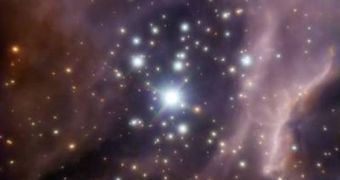The aptly named RCW 38 is one of the densest star clusters known, located some 5,500 light-years away, in the direction of the constellation Vela. The embedded cluster, termed that way because the immensely vast amounts of dust and gas that trigger star formation still envelop developing formations, is one of the structures of the Universe that was recently determined to be the source for most of the low-mass, reddish stars around today. While peering in the center of this stellar nursery, during the sharpest observations ever made of the structure, astronomers made an incredible discovery.
Harvard-Smithsonian Center for Astrophysics graduate student Kim DeRose took to the European Southern Observatory (ESO) for her new observations, and used the Nasmyth Adaptive Optics System (NAOS) / Near-Infrared Imager and Spectrograph (CONICA) instruments on the famous Very Large Telescope (VLT) for the job. The expert focused all observation power on a small area in RCW 38's core, where the massive star IRS2 had been previously identified.
Astronomers had observed that this star had an unusual color, with its surface all white. The searing, white-blue range actually represents the hottest surface color and temperature possible for any star. In the sharpest image of the object ever taken, DeRose discovered that IRS2 was in fact a binary star system, with two giant stars revolving around each other at a distance of about 500 AUs (Sun-Earth distances).
In the immediate vicinity of the star system, experts identified numerous budding protostars, which somehow managed to thrive in the hellish landscape without being torn apart by the massive amounts of powerful ultraviolet light radiated by IRS2. Chances of them actually developing are, however, fairly slim, as the radiation emitted by the binary system heats and disperses the cosmic dust and gas clouds that could have otherwise collapsed into full-blown stars.
In these stellar nurseries, there are worse things to threaten the existence of young stars than UV radiation. For instance, supernova explosions occur here fairly often, as massive stars reach the end of their life cycle, and blow up, scattering significant amounts of peculiar isotopes of chemical elements in the nearby space. These isotopes eventually make their way in the new generation of stars, where the cycle begins to repeat itself.
Astronomers can now say for sure that our Sun was one of the stars formed in a stellar nursery similar to RCW 38, because traces of such rare isotopes, which are not formed anywhere else in the Universe, have been discovered in its composition as well. “Overall, the details of astronomical objects that adaptive optics reveals are critical in understanding how new stars and planets form in complex, chaotic regions like RCW 38,” study co-author Dieter Nurnberger concludes. A paper detailing the finds appears in the latest issue of the Astronomical Journal.

 14 DAY TRIAL //
14 DAY TRIAL //